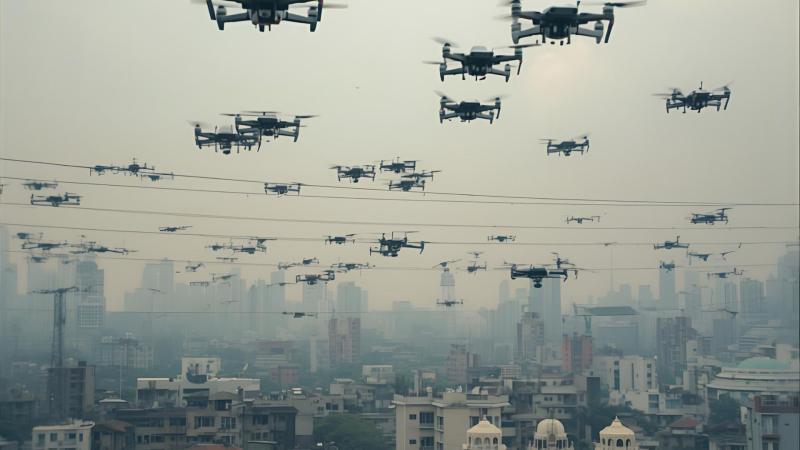
Drones have become ubiquitous in the past decade, being used for everything from deliveries to defence. Drones have even been deployed in their hundreds to create elaborate murals in the sky, with the swarm of drones coordinating their movements, much like a murmuration in a flock of birds. In such swarms, the ability to control them in coordinated formations is crucial, as a misstep by a single drone could cause the entire swarm to collapse.
New research from the Indian Institute of Technology Bombay has developed a quick and efficient method for drones to make decisions and adjust their positions, all based on observing their partners. Conventional methods of controlling swarms often rely on GPS, which can be jammed or unavailable. They also require drones to constantly communicate their positions and velocities, which drains precious battery life and increases payload. The new research provides a solution to both of these problems.
The team developed a method called bearing-only formation tracking control. Here, instead of knowing the precise coordinates of every other drone, each drone only needs to know the direction or bearing of its neighbours. This information can be gathered using simple, passive optical sensors, like cameras, making the system ideal for vision-based applications. These camera-based measurements are generally less prone to noise than traditional distance sensors, simplifying the drone's sensor systems and reducing the overall weight, which is a huge advantage for smaller Unmanned Aerial Vehicles (UAVs). Additionally, relying on passive sensors means that no radio signals are transmitted, making it particularly useful for covert military operations or in environments where radio communication is restricted.
Did You Know? Bearing-only control is inspired by how animals like birds or fish maintain formation, using only visual cues about their neighbors' directions. |
The researcher particularly focused on Vertical Take-Off and Landing (VTOL) UAVs, which are complex machines. Unlike simpler kinematic models often used in control research, VTOL UAVs are underactuated dynamic models. This means they have more degrees of freedom (ways they can move) than direct control inputs, making them much harder to control precisely. Previous attempts to apply bearing-only control to these dynamic models often fell short, with stability proofs that didn't quite hold up or control laws that introduced singularities – mathematical points where the system breaks down.
The new method developed in this study created new control laws and, crucially, provided rigorous mathematical proofs that guarantee Global Uniform Asymptotic Stability. This means that, under their control, the drones will reliably converge to and maintain their desired formation, even when starting from imperfect positions.
Their work addresses two primary scenarios: constant-velocity formation tracking and time-varying formation tracking. For constant velocity scenarios, drones use only the bearings and the rate at which those bearings are changing to maintain their formation, much like a car driver adjusting their position based on the location of other cars and the rate at which their relative positions are shifting. For the more complex time-varying scenarios, where the formation might need to change shape or the leader drone might be accelerating or turning, the drones also incorporate their own velocity measurements. These can be obtained using visual inertial odometry techniques, which combine camera data with internal motion sensors, again avoiding the need for GPS or inter-drone communication. To handle the rapid changes and potential noise in time-varying situations, the researchers also implemented a command filter, which smooths out control signals and prevents erratic movements.
The new study also improves on prior methods in its ability to handle arbitrary time-varying configurations. This is vital for real-world applications where drones might need to navigate through narrow passages, requiring them to temporarily reconfigure into a single line, or adapt to changing mission requirements. Many previous systems were limited to very specific types of manoeuvres, like simple translations or rotations. Furthermore, their control design is distributed, meaning each drone makes its own decisions based on local information from its neighbours, rather than relying on a central command. This enhances robustness, as the failure of one drone doesn't cripple the entire swarm.
Another critical aspect is the directed interaction among agents. Instead of every drone needing to sense every other drone (bidirectional sensing), their system allows for a more efficient, one-way sensing pattern, where each drone might only need to sense two specific neighbours. This significantly reduces the sensing requirements, making the system simpler and more energy-efficient. The researchers also highlight how their work rectifies serious flaws in previous stability proofs for dynamic VTOL models, particularly issues related to mathematical singularities in attitude extraction and incorrect assumptions about time-varying matrices.
The new model, however, focuses on multirotor VTOL UAVs, and future investigations could extend it to fixed-wing UAVs or convertible VTOL-fixed-wing hybrids. Real-world implementation will also need to contend with environmental noise, signal interference, and maintaining line-of-sight constraints in complex terrains. However, the foundational stability and control laws established here provide a robust framework for tackling these challenges. By enabling complex, dynamic formation flying with minimal sensors, no inter-drone communication, and no reliance on GPS, their work paves the way for a new generation of autonomous UAVs that will be more versatile, resilient, and efficient, capable of performing critical tasks in diverse and challenging environments.






